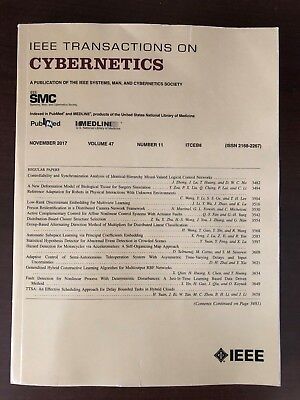Adaptive Safety-Based Tracking Control for Uncertain Robotic Systems With Input-Output Constraints: A Neural Network-Based Augmented High-Order Control Barrier Function Approach.
IF 9.4
1区 计算机科学
Q1 AUTOMATION & CONTROL SYSTEMS
引用次数: 0
Abstract
This article investigates the trajectory tracking control of uncertain robotic systems with limited control torque input bounds and joint position constraints. A novel neural network-based augmented high-order control barrier function (NN-AHoCBF) is proposed to facilitate the tracking control strategy of uncertain robotic systems with input-output constraints, where the neural network (NN) is used to estimate uncertainties in the robotic system dynamics, and the bounds of NN approximation errors and NN weights are adapted in the high-order time derivative of the HoCBFs. The NN-AHoCBF is then derivated with a series of time-varying functions, and auxiliary systems are constructed to guarantee the time-varying functions to be HoCBFs. In this way, the control input of the robotic system is relaxed by adjusting the time-varying functions through the inputs of auxiliary systems in NN-AHoCBF barrier conditions. Also, the sufficient condition for the NN-AHoCBF is provided to adaptively ensure system safety. The adaptive safety-based tracking control method is designed based on NN-AHoCBF in quadratic program (QP) framework, which can not only satisfy input-output constraints simultaneously, but also achieve good robustness and tracking performance. A simulation example is performed on a two-DOF robotic mainpulator to verify the effectiveness of the developed controller.具有输入输出约束的不确定机器人系统自适应安全跟踪控制:一种基于神经网络的增广高阶控制障碍函数方法。
研究了不确定机器人系统在有限控制力矩输入边界和关节位置约束下的轨迹跟踪控制问题。针对具有输入输出约束的不确定机器人系统的跟踪控制策略,提出了一种基于神经网络的增广高阶控制障碍函数(NN- ahocbf),利用神经网络估计机器人系统动力学中的不确定性,并在高阶时间导数中调整神经网络逼近误差和神经网络权值的取值范围。然后用一系列时变函数推导出NN-AHoCBF,并构造辅助系统以保证时变函数为hocbf。这样,在NN-AHoCBF障碍条件下,通过辅助系统的输入调节时变函数,放松机器人系统的控制输入。给出了NN-AHoCBF自适应保证系统安全的充分条件。在二次规划(QP)框架下,设计了基于NN-AHoCBF的自适应安全跟踪控制方法,该方法不仅能同时满足输入输出约束,而且具有良好的鲁棒性和跟踪性能。以二自由度机械手为例进行了仿真,验证了所设计控制器的有效性。
本文章由计算机程序翻译,如有差异,请以英文原文为准。
求助全文
约1分钟内获得全文
求助全文
来源期刊

IEEE Transactions on Cybernetics
COMPUTER SCIENCE, ARTIFICIAL INTELLIGENCE-COMPUTER SCIENCE, CYBERNETICS
CiteScore
25.40
自引率
11.00%
发文量
1869
期刊介绍:
The scope of the IEEE Transactions on Cybernetics includes computational approaches to the field of cybernetics. Specifically, the transactions welcomes papers on communication and control across machines or machine, human, and organizations. The scope includes such areas as computational intelligence, computer vision, neural networks, genetic algorithms, machine learning, fuzzy systems, cognitive systems, decision making, and robotics, to the extent that they contribute to the theme of cybernetics or demonstrate an application of cybernetics principles.
 求助内容:
求助内容: 应助结果提醒方式:
应助结果提醒方式:


